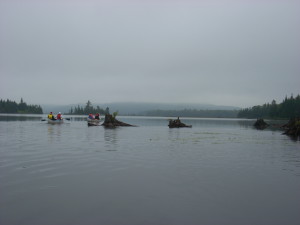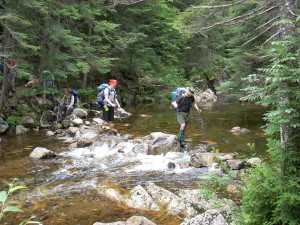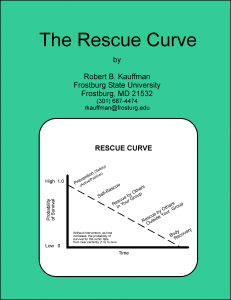 In the wilderness, whether on land or on water, reported incidents make clear that rescue of one or more participants may be necessary. Whether the desired rescue is ultimately possible or successful depends on a number of factors, including the skill level of the participants, the ability to self-rescue, the environmental conditions, and the ability to contact rescuers, among others. For instance, has the group placed itself into a position where, absent outside intervention, tragedy may be inevitable?
In the wilderness, whether on land or on water, reported incidents make clear that rescue of one or more participants may be necessary. Whether the desired rescue is ultimately possible or successful depends on a number of factors, including the skill level of the participants, the ability to self-rescue, the environmental conditions, and the ability to contact rescuers, among others. For instance, has the group placed itself into a position where, absent outside intervention, tragedy may be inevitable?
These concepts are made visually clear by reference to the “Rescue Curve” developed by Dr. Robert Kauffman (Frostburg State University, Integrated Risk Management for Leisure Services, 2013), which depicts the time-progression relationship between incident avoidance or prevention, self-rescue, rescue by others in the group, rescue by non-group members, and finally, injury, damage, or loss absent successful rescue.
As hypothesized by Dr. Kauffman, if the initial planning process does not result in avoidance of the incident, the time-wise progression becomes one of the need for self-rescue, rescue by members of the group, and finally, rescue by non-group members (such as volunteers or professional emergency personnel). If none of these rescue attempts are successful, then as time progresses, the odds of injury, damage, or loss (death?) become more certain, and mere hope becomes the plan.
By way of example, in 2014, two of three canoes of a Northern Tier crew, caught in a summer storm, swamped under challenging conditions, with a third canoe seeking refuge on a nearby island. One of the swamped crews was able to self-rescue by making it to shore, while the other swamped canoe was rescued by campers on shore. The campers also provided food, clothing and clothing to a second crew of Northern Tier staff members serving as a work crew who had been caught exposed in the storm without adequate gear. This story makes clear that, at a minimum, a group should plan for an instance where self or group rescue may be necessary.
Such planning should also take into account a realistic view of whether non-group assistance will be available, in the event that the group’s attempt at self- or group-rescue is unsuccessful.

For instance, crews on a Maine high adventure trek must rely on the Maine Warden Service in time of emergency, whose availability depends on time, weather, and locale. The Warden Service informs the author that, in the event of a backcountry emergency, evacuation may occur by means of float plane, boat, medical evacuation helicopter, National Guard helicopter, or on foot. Of course, a successful evacuation depends on the injured party being able to determine their location. And, the crew may be required to transport the injured party to a location where they can meet rescuers (trail head, road access, large lake). The Warden Service advises that the time to reach professional medical care, in a best case scenario, may range from 4 to 8 hours. In the event of bad weather, if air evacuation is required, it could be as long as 24 to 48 hours.
In one instance, it reportedly took 12 hours to remove a hiker with a fractured ankle from the Appalachian Trail. Of course, cell phone coverage in the Maine backcountry may be non-existent, so the biggest obstacle to obtaining professional medical care may be lack of communication means.
Indeed, this summer 2015 Boundary Waters story makes clear that help may not always “be on the way” in the wilderness, nor be “just around the corner” time-wise.
And, BSA youth protection rules must be followed in the event of an evacuation, removing a leader from the crew. Similar issues exist with respect to crews operating in isolated sections of the Boundary Waters. These are potential impediments to rescue to keep in mind.
This summer 2015 ocean kayak story confirms what problems can be faced when self-rescue is not possible.
This story confirms how the lack of ability to self- or group-rescue during a backpacking trip in the Colorado mountains involving 43 scouts and adults resulted in a need to call for assistance. Rescue required six hours.
A Colorado rescue of 3 hikers required 21-hours, 25 responders, and the use of a variety of equipment, including ATVs, conventional vehicles, specialized equipment and a couple of helicopters.
And, this story makes clear that an accident during a cave expedition may require outside assistance which can take hours to arrive (in this instance, rescue required seven hours).
Finally, a 10 person hiking group used a satellite phone to seek help for a hypothermic and dehydrated group member in the Colorado mountains. The rescue ultimately required 7 hours and 16 rescue personnel, reaching the distressed hiker via ATVs and hiking over the final 4 miles, treating the hiker for dehydration on the spot. Dehydration and hypothermia are issues that a well-prepared hiking group might, by some, be thought to be able to deal with, or prevent, from a group-rescue standpoint.
Certainly, it would be expected that a Scout group, hiking under such circumstances, with sufficient training and experience, and good group dynamics, should be able to avoid issues of dehydration and hypothermia in such an environment (replicating Philmont in many respects).
“Be Prepared” means thinking ahead in an attempt to anticipate those instances where all may not be going well, and arriving at steps to take to avoid arriving at the bottom of the Rescue Curve!
Finally, a “Rescue Curve” story from the July 9, 2018 edition of The Washington Post:
“The Montgomery County Fire and Rescue service was called to Black Hill Regional Park, where a canoe had overturned, leaving people in the water, authorities said. However, it turned out that the three people from the canoe ‘self-rescued’. They ‘got back into the boat’ a spokesman said, and ‘went on their way’. Rescue personnel were not required.” 🙂

